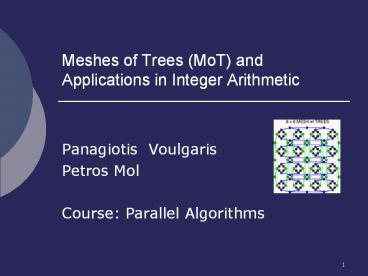Meshes of Trees (MoT) and Applications in Integer Arithmetic - PowerPoint PPT Presentation
Title:
Meshes of Trees (MoT) and Applications in Integer Arithmetic
Description:
Meshes of Trees (MoT) and Applications in Integer Arithmetic Panagiotis Voulgaris Petros Mol Course: Parallel Algorithms Outline of the talk The two-Dimensional Mesh ... – PowerPoint PPT presentation
Number of Views:112
Avg rating:3.0/5.0
Title: Meshes of Trees (MoT) and Applications in Integer Arithmetic
1
Meshes of Trees (MoT) and Applications in Integer
Arithmetic
- Panagiotis Voulgaris
- Petros Mol
- Course Parallel Algorithms
2
Outline of the talk
- The two-Dimensional Mesh of Trees
- Definitions
- Properties
- Variations
- Integer Arithmetic Applications
- Multiplication
- Division
- Powering
- Root Finding
3
Definition
- Construction
grid
Mesh of Trees
Nodes
4
Properties
- 1)Diameter (maximum distance between any pair of
processors) 4logN
Proof
Case 1 u belongs to a row tree and v to a column
tree
Distlt2logN 2logN
5
Properties (cont.)
- Case 2u,v belong only to row trees (or only to
column trees)
DistlogN r 2logN logN slt4logN
since rgts
6
Properties (cont)
- 2)Bisection Width(the minimum number of wires
that have to be removed in order to disconnect
the network into two halves with almost
identical number of processors) N - (Proof omitted)
Thus meshes of trees enjoy both small diameter
and large bisection width. This fact makes them
a more efficient structure than arrays and simple
trees
7
Recursive Decomposition
Mesh of trees
Four disjoint copies of
Mesh of trees
Importance This property makes mesh of trees
appropriate for recursive algorithms for parallel
computation
8
Ideal Parallel Computer
PM
PM
P Processor M Memory
PM
PM
Every processor is linked to every other
processor. Advantage Speed !! Drawback Cost
PM
PM
PM
PM
9
Ideal Parallel Computer
Process/Memory separation
Every Processor has direct access to a memory
register
Again here the degree of each node becomes large
as the number of processor increases
Idea Why not simulate the complete bipartite
graph?
10
Ideal Parallel Computer
11
Ideal Parallel Computer
12
Ideal Parallel Computer
13
Benefits and Drawbacks
- Simulation of any step of in 2logN
steps
- Bounded degree graph with essentially the
computational power as
We have actually constructed the NxN mesh of
Trees
- The mesh of Trees has nearly nodes
whereas the initial complete bipartite graph had
only 2N Solution Later
14
Transformation to mesh of Trees
Back
15
Variations
- 1)
16
Variations (cont)
17
Variations (cont)
2)
18
Variations (cont.)
3)
19
Variations (cont.)
4)































